WBBSE Class 9 History Chapter 6 The Second World War And Its Aftermath Topic A The Causes and Course of the Second World War Short Answer (SA) Type Questions
Answer in 2 to 3 sentences
Question 1. Name the Allied and Axis powers in the Second World War.
Answer:
Allied And Axis Powers In The Second World War:-
In the Second World War, the Allied powers were England, France, USSR, USA and China. The Axis powers were Italy, Germany and Japan.
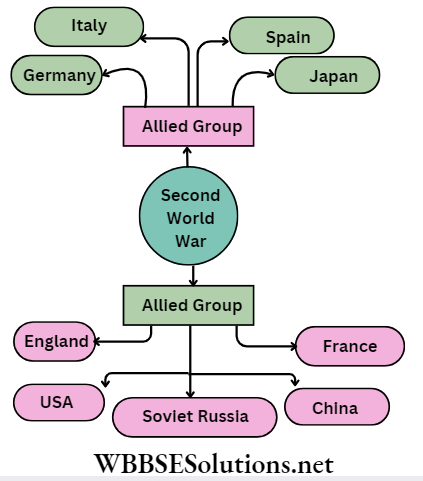
Question 2. Through which military campaign did Mussolini try to fulfil his imperial ambition?
Answer: The fascist government under Mussolini became hungry for colonies and Mussolini tried to fulfil his imperial ambitions through his military campaign in the East African country of Ethiopia (Abyssinia). In 1935 he attacked Ethiopia to exploit its minerals and raw materials for industrial development and Ethiopia was formally annexed in 1936.
Read and Learn More WBBSE Class 9 History Short Answer Questions
Question 3. Write a note on the bombing by USA at Hiroshima and Nagasaki.
Answer:
Bombing By USA At Hiroshima And Nagasaki:-
USA prepared a plan to drop a newly discovered atomic bomb on Japan on August 6, 1945. The atomic bomb was dropped on Hiroshima, an industrial town in Japan, which destroyed half the city and caused 80,000 deaths. This was the first use of the atom bomb during World War II.
WBBSE Class 9 History
On August 9, a second atomic bomb was dropped in Nagasaki in Kyum, destroying the whole municipal area and killing 40,000 people. The whole world was alarmed at the extensive destructive capacity of these
new weapons.
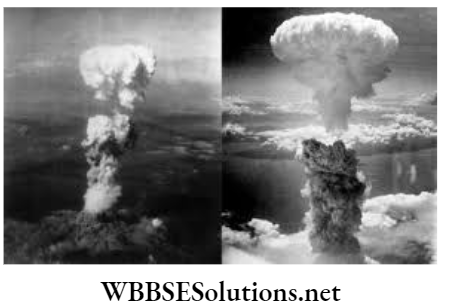
Question 4. Why did Hitler sign the Munich Pact?
Answer:
Hitler Sign The Munich Pact:-
England and France followed the policy of appeasement towards Hitler and signed the Munich Pact in 1938. Hitler agreed to sign the Munich Pact because-
[1] Germany was authorised to occupy four border provinces of Czechoslovakia within ten days.
WBBSE Class 9 History
[2] The Czechoslovakian government was forced to release all the political prisoners of Sudeten- land. This territory was also given to Germany.
Question 5. Which incident forced the USA to join the Second World War?
Ans. The sudden Japanese air attack with 360 aircraft struck at the American fleet at Pearl Harbour in the Hawaiian Islands on 7 December 1941″ and wiped out all the American planes on the ground there. This incident at Pearl Harbour forced USA to join the Second World War.
Question 6. Write a note on the Battle of Leningrad.
Answer.
Battle Of Leningrad:-
At the initial stage of the Second World War, the German army achieved great success. They besieged Leningrad. The Soviet army followed the ‘Scorched Earth’ policy and guerilla model of warfare. As a result, the Nazi forces began to retreat. In the beginning of 1942, Leningrad was vacated by the Russian Red Army.
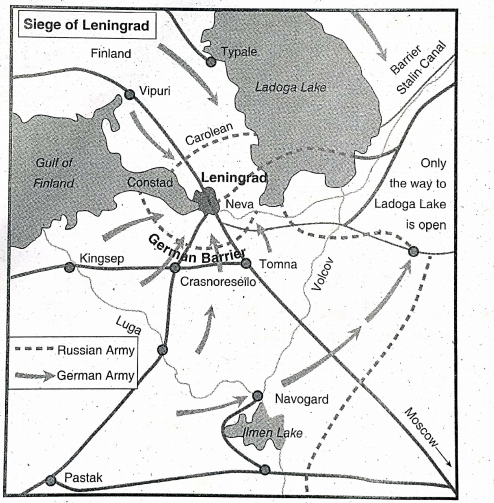
Question 7. Which book is known as the ‘Bible of the Nazi Party’? Who was its author?
Answer:
1. ‘Mein Kampf is known as the Bible of the Ans.! In 1933 Germany withdrew from the Nazi Party.
2. Its author was Hitler.
Question 8. Why did Germany withdraw from the League of Nations?
Answer: In 1933 Germany Withdrew from the League of Nations. According to the terms of the Treaty of Versailles Germany was disarmed. Germany’s demands for military parity with other European powers was refused by the western powers, so Germany withdrew herself from the League of Nations.
History Class 9 WBBSE
Question 9. What was Vichy government?
Answer:
Vichy Government:-
A puppet French government led by Petain was established under the control of Germany in France. As Vichy was the capital of this new French government it was also called the Vichy Government.
Question 10. When was the Yalta Conference held? Name the countries which took part in the Yalta Conference.
Answer:
1. The Yalta Conference was held in 1945.
2. The countries which took part in the Yalta Conference were USA, Britain and Russia.
Question 11. Name three prominent leaders who attended the Yalta Conference. Name any two military alliances which came into being as a consequence of Cold War.
Answer:
Three prominent leaders who attended the Yalta Conference were-
[1] Roosevelt, the President of America
[2] Churchill, the British Prime Minister and
[3] Stalin, the President of USSR.
History Class 9 WBBSE
Two military alliances which came into being as a consequence of Cold War were-
[1] NATO (North Atlantic Treaty Organisation) and
[2] Warsaw Pact.
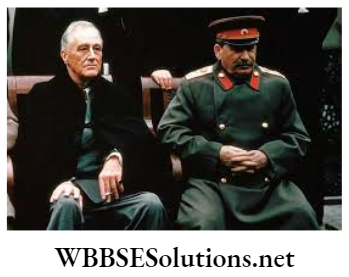
Question 12. What is Operation Barbarossa?
Answer:
Operation Barbarossa:-
On June 22, 1941 Nazi Germany and her allies began a massive invasion of the Soviet Union under Operation Barbarossa. Hitler changed the original name Operation Fritz to Operation Barbarossa to refer to Frederick Barbarossa, the Holy Roman Emperor, who had set out to conquer the Holy land in 1190.
History Class 9 WBBSE
Question 13. What is Seigfreid Line?
Answer:
Seigfreid Line:-
Seigfreid Line was a line of defensive forts and tank defences built along the German western frontier opposite the French Maginot Line in the 1930s and greatly expanded in 1941.
Question 14. Name the principal dictators of Europe who rose to power after the first World War.
Answer: The principal dictators of Europe who rose to power after the First World War were Mussolini of Italy, Hitler of Germany and general Franco of Spain.
Question 15. What were the main aims of Hitler’s foreign policy?
Answer:
The main aims of Hitler’s foreign policy were:
[1] To revise the humiliating treaty of Versailles.
[2] To unify Germany and to unite all German-speaking people into one Reich.
[3] The eastward expansion of Germany to achieve ‘Lebensraum’ (Living space).
[4] To make Germany a strong and powerful nation and to destroy communism.
Class 9 History WBBSE
Question 16. What is the significance of Italy’s attack on Abyssinia?
Answer:
The significance of Italy’s attack on Abyssinia was:
[1] It exposed the weakness of the League of Nations.
[2] The prestige of the League of Nations was damaged.
[3] Italy’s attack on Abyssinia encouraged Hitler in his aggressive policy.
[4] Italy and Germany came closer together.
Question 17. What steps were taken by the League of Nations when Italy attacked Abyssinia?
Answer: When Italy attacked Abyssinia, the League of Nations declared Italy as an aggressor country. Moreover, the League of Nations directed the member countries of the League to stop all sorts of commercial relationships with Italy.
Question 18. Why did Hitler and Mussolini come closer to each other and become allies?
Answer:
The reasons why Hitler and Mussolini came closer to each other and became allies were:
[1] Both were against the Treaty of Versailles signed in 1919.
[2] France was the enemy of both Italy and Germany.
[3] Both countries were supporters of aggressive nationalism.
Question 19. Give some examples of the Anglo-French policy of appeasement.
Answer:
Some examples of the Anglo-French policy of appeasement were:
[1] Italy’s attack on Abyssinia.
[2] Franco’s military regime was supported by Hitler and Mussolini during the Spanish Civil War.
[3] Occupation of Austria by Germany, England and France remained inactive during the aggressive policy of Italy and Germany.
Class 9 History WBBSE Chapter 6 The Second World War And Its Aftermath Topic B Impact of the Second World War and Ultranationalism vs Internationalism Short Answer (SA) Type Questions
Answer in 2 to 3 sentences
Question 1. How can you explain the Second World War as a struggle between Fascism and Nazism versus Democratic ideals?
Answer: The Second World War was in fact, the struggle of two contradictory principles, i.e, Fascism and Nazism versus democratic principles. England, France and America were the supporters of the principles of democracy, while the principles of autocracy were fully supported by Nazi Germany and Fascist Italy. Thus war was inevitable between the supporters of these two contradictory principles.
Question 2. What is UNRRA?
Answer:
UNRRA:-
As a result of the Second World War there was total destruction, devastation and despair in the whole of Europe. In order to regenerate the economy of the devastated countries United Nations Relief and Rehabilitation Administration (UNRRA) was set up in 1943 in Washington, USA.
It was an international body to provide relief to countries liberated from the German occupation. This economic recovery programme provided substantial economic help to war-ravaged countries like Poland, Italy, Yugoslavia, Czechoslovakia, Greece, Austria etc.
Question 3. What was the ‘Fulton Speech’?
Answer:
Fulton Speech:-
On 5 March 1946 the former British Prime Minister Winston Churchill delivered a speech at Westminster College, Fulton in the state of Missouri, USA. He warned that a large part of Europe from Stettin to Triest had passed under the ‘iron curtain’ of the Soviet Union. He warned that America should become alert otherwise the Soviet Union would one day conquer the entire continent of Europe.
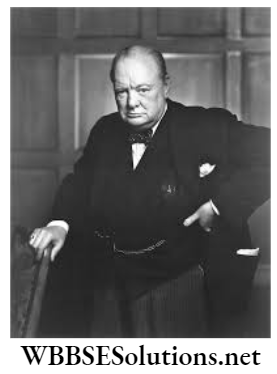
Question 4. What is Marshall Plan?
Answer:
Marshall Plan:-
The American Foreign Secretary, George Marshall, in a lecture at Harvard University spoke of a plan of the economic resurgence of war-ravaged countries like France, Britain, Belgium, Italy, West Germany etc. Marshall observed, “It is logical that the United States should do whatever it is able to do to assist in the return of normal economic health in the world, without which there can be no political stability and no assured peace.
” This plan of Marshall which wanted to save Europe from poverty, hunger and lawlessness is known as the Marshall plan, a programme to finance the recovery of the European economy.
Question 5. What is internationalism?
Answer:
Internationalism:-
Internationalism is a movement which advocates economic and political cooperation among nations for the benefit of all. It is the belief that countries can achieve more advantages by working together and trying to understand each other than by arguing and fighting wars with each other.
Question 6. What is nationalism?
Answer:
Nationalism:-
Nationalism is basically a collective state of mind or consciousness in which people believe their primary duty is loyalty to the nation-state. It implies national superiority and glorifies various national virtues. It is a political or social philosophy in which the welfare of the nation-state as an entity is considered paramount.
Question 7. What do you mean by ultranationalism?
Answer:
Ultranationalism:-
Nationalism is an ideology that emphasises devotion and loyalty to a nation or nation-state. Ultranationalism is an extreme form of nationalism. It is simply extreme devotion to one’s own nation and of the paramount importance of advancing it regardless of the effect on any other nation.
Class 9 History Book West Bengal Board WBBSE Question 8. What was decided in the Potsdam Conference?
Answer:
The decisions arrived at the Potsdam Conference were
[1] Germany will be deNazified. The Nazi Party would be banned and its leaders would be tried as war criminals.
[2] Germany will be demilitarized
[3] Germany’s large industrial factories would be dissolved.
Question 9. What are the features of ultra-nationalism?
Answer:
The features of ultranationalism are as follows:
[1] It is an extreme form of nationalism.
[2] It believes in the superiority of one’s own nation.
[3] It glorifies national identity.
[4] It includes elements of racism and fanaticism which can lead to conflict.
[5] It may involve contempt for other nations.”
[6] It supports authoritarian political arrangements.
Question 10. Name the leaders who joined the Potsdam Conference.
Answer: The leaders who joined the Potsdam Conference were Joseph Stalin of Russia, Harry S Truman of USA and Clement Attlee of Britain.
Question 11. How was Germany divided after the Second World War?
Answer: After the Potsdam Conference, Germany was divided into four occupied zone: France in the southwest, the United States is the south, Great Britain in the northwest and Soviet Union in the east. Berlin, the capital of Germany was also divided into four occupied zones.
Question 12. Mention some military equipment used during the Second World War.
Answer: Some military equipment used during the Second World War were machine guns, long-range rockets, handguns, marine, mortar, grenade launchers, submarines, modern tanks, mines etc.
Question 13. What do you understand by the term stand by the term ‘Third World’?
Answer: While the post-1945 world saw a ‘bi-polar’ world (divides into USA and Soviet spheres of influence), it also witnessed the emergence of the ‘Third World’. A group of countries in Asia, Africa and Latin (South) America which achieved independence after the Second World War and did not formally belong to either of the two rival blocs and later launched the Non-Alignment Movement in international relations is known as the Third World.

